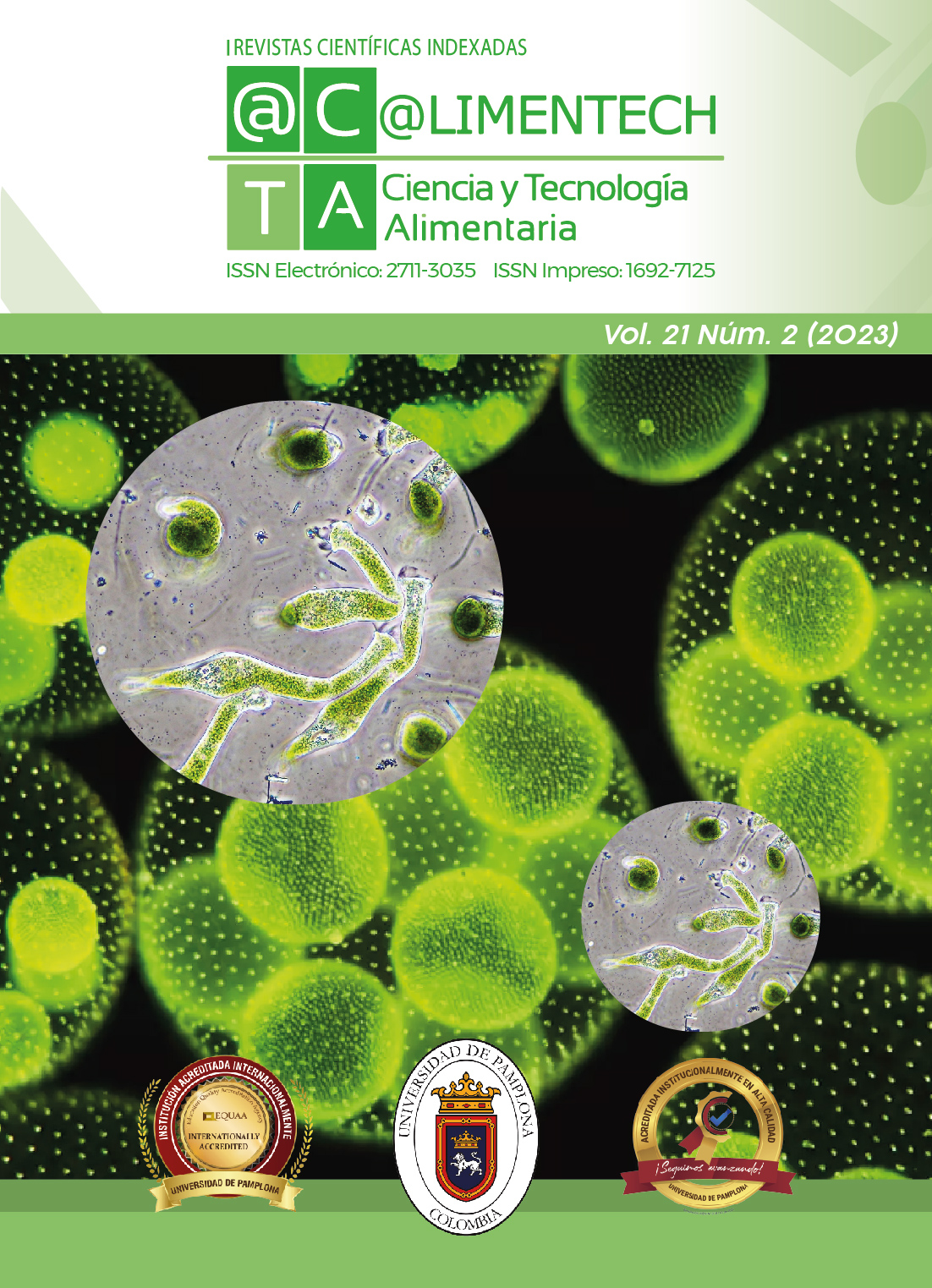Evaluation of the impact of an edible coating on the conservation of guava (psidium guajava)
DOI:
https://doi.org/10.24054/limentech.v21i2.2643Keywords:
Fruits, guava, coating, shelf lifeAbstract
Edible coatings are described as a thin, transparent and edible layer that surrounds a food, usually by immersing it in a solution that forms the coating in order to contribute to the preservation of the quality of the food matrix and in turn, provide packaging. The objective of the present study was to evaluate the efficiency of edible coatings on the shelf life of immature green guava (Psidium guajava L), for which K- carrageenan and glycerol were used as coating material and plasticizing material, respectively, as well as the CIE L*A*B, DeltaE coordinates for the determination of color changes as a function of maturity and storage conditions at room temperature (30 C) for 10 years. days. As a result, the coating made with K-carrageenan managed to maintain the properties of the fruit for longer, which allows us to verify that the use of this coating is a feasible preservation method that helps to delay ripening and, therefore, increase the shelf life of fruits such as guavas.
Downloads
References
Andrade, J., Acosta, D., Bucheli, M., & Osorio, O. (2014). Desarrollo de un recubrimiento comestible compuesto para la conservación del tomate de árbol (Cyphomandra betacea S.). Revista Ciencias Agrícolas, 25(6), 57-66. https://doi.org/10.4067/S0718-07642014000600008
Bezerra, A., Fitzgerald, A., & Santana, L. (2014). Impact of edible chitosan–cassava starch coatings enriched with Lippia gracilis Schauer genotype mixtures on the shelf life of guavas (Psidium guajava L.) during storage at room temperature. Food Chemistry, 171, 108-116. https://doi.org/10.1016/j.foodchem.2014.08.077
Calsada-Uribe, N. J., Caballero-Pérez, L. A., & Soto-Tolosa, E. P. (2022). Elaboración de una barra proteica con recubrimiento de un gel energético a base de café. Revista @limentech, Ciencia y Tecnología Alimentaria, 20(2), 5-23.
Del-Valle, V., Hernández-Muñoz, P., Guarda, A., & Galotto, M. (2005). Development of a cactus-mucilage edible coating (Opuntia ficus indica) and its application to extend strawberry (Fragaria ananassa) shelf-life. Food Chemistry, 91(4). https://doi.org/10.1016/j.foodchem.2004.07.002
Durango, A., Soares, N., & Arteaga, N. (2011). Edible films and coatings as biodegradable active packaging in the preservation of food products. Biotecnología en el Sector Agropecuario y Agroindustrial, 9(1), 112-118.
Fernández, N., Echeverria, D., Mosquera, S., & Pazestado, S. (2017). Estado actual del uso de recubrimientos comestibles en frutas y hortalizas. Biotecnología en el Sector Agropecuario y Agroindustrial, 15(2), 134-141. https://doi.org/10.18684/BSAA(15)134-141
Gallo, Y., Toro, L. F., Jaramillo, H., Gutiérrez, P. A., & Marín, M. (2018). Identification and molecular characterization of the complete genome of three viruses infecting lulo (Solanum quitoense) crops in Antioquia (Colombia). Revista Colombiana de Ciencias Hortícolas, 12(2), 281-292.
Guavita, J., Avellaneda, L., Solarte, M., & Melgarejo, L. (2018). Carotenoides, clorofilas y pectinas durante la maduración de variedades de guayaba (Psidium guajava L.) de Santander, Colombia. Revista Colombiana de Ciencias Hortícolas, 12(2). https://doi.org/10.17584/rcch.2018v12i2.7717
Guerreiro, A., Gago, C., Faleiro, M., Miguel, M., & Antunes, M. (2014). The effect of alginate-based edible coatings enriched with essential oils constituents on Arbutus unedo L. fresh fruits storage. Postharvest Biology and Technology, 1, 226-233. https://doi.org/10.1016/j.postharvbio.2014.09.002
Lin, M. G., Lasekan, O., Saari, N., & Khairunniza-Bejo, S. (2018). Effect of chitosan and carrageenan-based edible coatings on post-harvested longan (Dimocarpus longan) fruits. CyTA - Journal of Food, 16(1).
Núñez, C. K., Castellano, G., Ramírez, M. R., Sindoni, M., & Marín, R. C. (2012). Efecto del cloruro de calcio y una cubierta plástica sobre la conservación de las propiedades organolépticas de la fresa (Fragaria x ananassa Duch). Revista Iberoamericana de Tecnología Postcosecha, 13(1), 21-30.
Paz, Y. (2018). La verdad detrás de la Carragenina. La Buena Nutrición, Revista para Profesional de la Salud, 13.
Peñaloza, R., & Hernández, M. (2018). Conservación de la uchuva (Physalis peruviana L.) mediante la aplicación de recubrimiento comestible a base de gel de aloe barbadensis miller. Revista @limentech, Ciencia y Tecnología Alimentaria, 16(2), 50-67.
Solano-Doblado, L., Alamilla-Beltrán, L., & Jiménez-Martínez, C. (2020). Películas y recubrimientos comestibles funcionalizados. TIP. Revista Especializada en Ciencias Químico-Biológicas, 21.
Talens-Oliag, P. (2017). Evaluación del color y tolerancia de color en alimentos a través del espacio CIELAB. Universidad Politécnica de Valencia.
Vargas, M., Gonzalez-Martinez, C., Chiralt, A., & Chafer, M. (2007). Estudio preliminar del uso de recubrimientos de quitosano y de microorganismos eficaces en el control postcosecha de la podredumbre azul de naranjas. V Congreso Iberoamericano de Tecnología Postcosecha y Agroexportaciones, 1416-1423, Valencia, España.
Vasconez, M., Flores, S., Campos, C., Alvarado, J., & Gerschenson, L. (2009). Antimicrobial activity and physical properties of chitosan–tapioca starch based edible films and coatings. Food Research International, 42, 762-769.
Downloads
Published
How to Cite
Issue
Section
License
Copyright (c) 2023 @limentech, Ciencia y Tecnología Alimentaria

This work is licensed under a Creative Commons Attribution-NonCommercial 4.0 International License.








